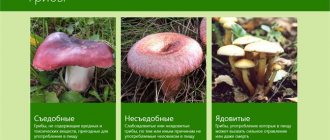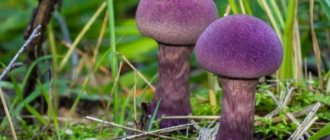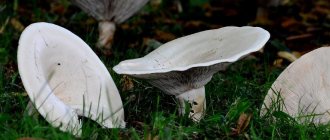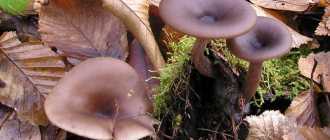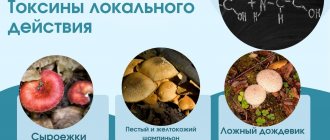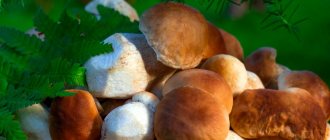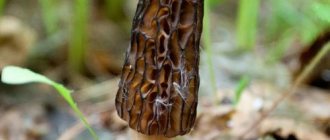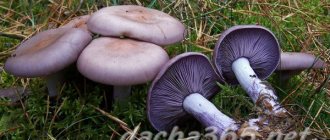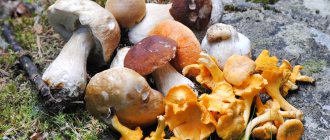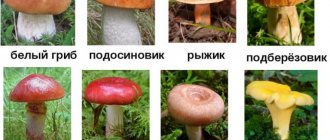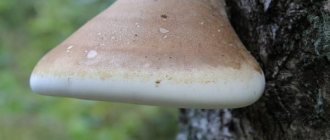Mushrooms are a kingdom of living nature that combines the characteristics of both plants and animals. Although for a long time they were mistakenly attributed specifically to plants. We attribute them to the flora, but not to plants, please do not confuse them. Although this is not entirely true.
Mushrooms are distributed throughout the world. They can be found on the ground, and underground, in the ground itself, and in the water. In general, almost everywhere. And there is nothing surprising in the fact that science knows hundreds of thousands of species of mushrooms. And according to some assumptions, there are more than a million species of them on our planet.
Classification of mushrooms in the photo
Mycology divides mushrooms into classifications, determining the degree of edibility of each family. Edible, conditional, inedible, poisonous and hallucinogenic varieties of the mushroom world allow germination close to each other, regardless of the forest zone. Some myceliums prefer coniferous deposits, others live in deciduous forests, and others take root far from the forest, choosing meadows, fields and areas close to water bodies as their habitat. However, despite this scatter, experienced mushroom pickers note that the collection is mainly carried out in mixed forests, combining deciduous and coniferous trees. Cunning increases the chances of a large harvest, reducing the time of quiet hunting to a minimum.
Classification of the mushroom world is the division of mushrooms according to the structure of the upper part or cap into categories:
- No. 1 - spongy
People can also hear an alternative name - tubular. They have a sponge-shaped cap structure. If you look at the inside more closely, you can compare the pattern with small tubes combined together.
- No. 2 - plate
It’s easy to guess that the category received an unusual name based on the structure of the cap. Mushrooms have plates that are visually similar to a fan.
- No. 3 - marsupials
The last category unites unusual mushrooms that have an “alien” cap structure. Morels and stitches that visually resemble the structures of walnuts and honeycombs belong to this classification.
Place of growth
The true saffron milkweed grows mainly in the central and northern parts of the country. It is found abundantly in the Urals, Siberia and southern mountainous regions.
For optimal growth of the fungus, a warm temperature regime of 15 to 27 degrees Celsius is required. Saffron milk caps grow in groups, forming a symbiosis with coniferous trees. They do not like shade and very wet soil; they prefer sandy loam soil.
The true camelina is found in the following places:
- coniferous forest;
- spruce or pine young growth;
- mixed forest;
- deciduous forest with spotty growth of pines and spruces.
When collecting camelina, you should pay special attention to the sides of forest roads, field edges, clearings and hills. These are his favorite places to grow! Often families of saffron milk caps coexist with butterflies.
Mushroom germination or silent hunting: places of growth, collection season
Most families of fungi resemble the germination of weeds. You can meet many subspecies not only in the forest, but also in the city. Honey mushrooms, oyster mushrooms, rows and champignons are often found in front gardens planted near entrances, roadsides and highways, landfills, cemeteries and industrial zones. However, collecting mushrooms in contaminated areas is not recommended. Mushrooms, like sponges, regardless of their edibility, easily absorb harmful substances into their pulp. It has been scientifically proven that even the most edible mushroom, growing on infertile contaminated soil, can become inedible and even poisonous due to toxins, poisons and carcinogens. To avoid such an experience on your body, it is recommended to carefully select places for quiet hunting. The further the territory is located from the city and contaminated areas, the better!
Depending on the region of residence, the beginning of the mushroom picking season may vary, ranging from a week to a full month. The first myceliums, according to average statistics, germinate from mid-April. Morels and strings appear in aspen and mixed forests. Following the first mushrooms, the May row, meadow and summer honey mushrooms, and boletuses (boletus and boletus) wake up. From the beginning of summer they wake up: raincoats, semi-ceps, russulas and rows, champignons. Noble mushrooms are in no hurry to germinate; the season begins at the end of July, ending with the onset of the first frost. Fans of chanterelles, porcini and Polish mushrooms, umbrellas and truffles should find out before the trip whether there are mushrooms in the forest today and what places are famous for collection in the region of residence. The answers to these questions are not difficult to find. Comments and reviews left in social networking groups and forums dedicated to silent hunting will provide coordinates.
To go home with a loot and not an empty bucket, you should carefully study the weather before heading into the forest. Butterflies, saffron milk caps, bluecaps and other edible mushrooms germinate after heavy rain. If the region experiences drought and high temperatures, it will be almost impossible to detect the fruits.
Important!
The optimal time for quiet hunting will be a week after the start of precipitation. When choosing a favorable day, you should exclude weekends, Monday and Tuesday. Competition is increasing these days, and young mushrooms do not have time to grow to become noticeable to the collector.
In the last few years, mycologists have not recommended collecting edible mushrooms that grow in the vicinity of the toadstool. The poisons of a dangerous mushroom can be transmitted in small quantities due to excessive saturation. You can avoid poisoning by walking past the neighboring couple.
Autumn remains the peak mushroom months. In September, October and November, it is possible to harvest more than in the entire summer. Assumption mushrooms, honey mushrooms, snotty boletus, noble milk mushrooms and boletus, saffron milk caps and other edible species, which have beautiful names and are no less rich in nutrients, are suitable for use as food after heat treatment or preparing preparations for the winter, drying and freezing.
During the winter months, mushrooms are quite rare. Only flammulina can be detected, but only at above-zero temperatures. When the indicators drop below 0, fruiting of even the most frost-resistant subspecies is suspended.
How to distinguish saffron milk mushrooms from saffron mushrooms by size
Size is another criterion that helps to recognize whether mushrooms are in front of a mushroom picker or saffron milk caps. The difference is not very noticeable, but it is there: the latter are slightly larger. The cap of the true saffron milk cap usually grows to 5-18 cm in diameter. In the pink trumpet it is smaller: 3-10 cm (occasionally reaches 15). But since most often you can find groups of young mushrooms with caps from 5 to 10 cm, solely on this basis it is difficult to understand how they differ. It is necessary to take into account other characteristic features.
Mushrooms, beneficial properties and composition
In comparison with other natural foods, mushrooms are classified as dietary products that practically do not contain carbohydrates. Almost more than 87% of the protein product contains water, which is necessary for the proper functioning of internal organs and the body as a whole. The remaining substances are proteins, fats, carbohydrates, fiber and ash. You can consume foods after heat treatment in your daily diet, despite dietary restrictions. Most diets and fasting days allow eating edible mushrooms, both individually and as an ingredient for first and second courses. Restrictions are imposed only on children under 13 years of age, pregnant women and nursing mothers, people with individual intolerance to the product and exacerbation of chronic gastrointestinal diseases and peptic ulcers. Use in case of contraindications is strictly prohibited!
Noble, edible and conditionally edible mushrooms, despite the name and classification, are preferentially used for the following reasons:
1) dietary nutrition and vegetarianism to replenish the daily intake of proteins and fats; 2) diabetes mellitus; 3) vitamin deficiency associated with a lack of amino acids and microelements contained in mushroom products; 4) folk treatment of various diseases, with the ability to prepare tinctures and ointments for rubbing, decoctions for oral administration.
Important!
The use of mushrooms with chronic diseases of the kidneys, liver, and gastrointestinal tract is allowed with extreme caution. Therapists advise using a protein product for steamed or boiled dishes. You should not prefer fried foods, which have a detrimental effect on the functioning of the digestive organs and make heavy foods heavier.
Chemical composition (value) in the photo
How to identify saffron milk caps or saffron milk caps by their pulp
A number of other reasons for distinction can be obtained by cutting the mushroom of interest. The photo below shows the pulp of saffron milk caps and volnushki. In these mushrooms it is dense and brittle, with a faint smell of resin, but that’s where the similarity ends. The flesh of saffron milk caps is orange, less often white-yellow. In volnushki it is white, cream or pale pink.
The thick juice, reminiscent of milk and protruding abundantly at the fracture of the fruiting body, is yellow or orange and bright in saffron milk caps. It leaves a red mark on your fingers. It is not at all hot, slightly spicy and even sweet in taste. At the same time, the juice of the moths is milky white or pale yellow, very acrid and bitter.
The smell of the camelina pulp at the breaking point is pleasant, fruity, with notes of sweetness. The pulp of the roseate has a sharp, bitter smell, slightly reminiscent of geranium.
What is the difference between a saffron milk cap and a saffron milkweed in cross-sectional color?
It is also interesting to observe what color the mushrooms and edible saffron milk caps are if you cut these mushrooms and let them sit in the air for a while.
The orange flesh of the camelina at the site of damage very quickly turns red. Pigmentation is formed due to the fact that certain substances in its composition are oxidized under the influence of air. Over time, the flesh in the crack will change color to grayish-green, just like dried juice of this mushroom or a place that has been pressed with force.
The pulp and juice of the volnushka do not change their color in the air. In the same way, the color of the area of its fruiting body does not change when pressed.
Edible mushrooms, breed names with pictures and brief description
Before you go on a quiet hunt for the first time, it is recommended that you study brief information with the name of each subspecies, which allows you to clearly determine what edible mushrooms look like.
White mushroom or boletus
The noble mushroom, found mostly in deciduous forests, has many admirers among lovers of quiet hunting. Compared to other mushrooms, it contains more useful substances and less water in the pulp, and has an impressive size. Germination of boletus occurs at the end of summer - beginning of autumn, stopping only in the fall, when frosts replace warm weather.
The captivating mushroom aroma, tenderness of the pulp and refined taste classify the porcini mushroom in the first category of edibility. After collection, the product does not require heat treatment. After rinsing under running water, cooks proceed directly to cooking, focusing on the recipe and step-by-step instructions.
Like other edible mushrooms, white mushrooms are not only consumed as food, but also used as the main ingredient for winter preparations. It makes a delicious marinade and pickles, frozen and dried product.
Most often, Russian cuisine offers the following recipes:
- rich dietary soups;
- first and second courses with the addition of meat and mushrooms;
- snacks for strong drinks;
- caviar;
- pickles cooked in a barrel.
Porcini mushrooms have false counterparts that contain poisons and carcinogens in their pulp. Before going on a quiet hunt, you should carefully study the distinctive features of the edible subspecies of porcini mushroom from the satanic and gall mushroom.
Today there are many varieties of porcini mushrooms with photos and names. Among them:
- reticulate;
- dark bronze;
- birch;
- pine;
- oak;
- spruce;
- royal or royal;
- semi-white.
Depending on the variety, the color scheme, structure of the stem and cap may differ.
Mosswort
When studying the names of mushrooms with pictures, a novice mushroom picker should pay special attention to the noble breed - moss mushroom. In comparison with other mushrooms, the variety of the Boletaceae family does not have false brethren, and most importantly, it stands out from the mushroom world with bright distinctive features. The mushroom cap is velvety, reminiscent of expensive fabric, used since ancient times for sewing shoes, clothes and accessories. Adult mushrooms are distinguished by cracking on the outer part, acquiring a rich greenish or brown tone. The varying color scheme allows the moss fly to easily camouflage itself, focusing on the colors found in the germination area.
Compared to other types of noble mushrooms, it does not change color when cut. It grows more often in swampy areas and ravines, where high moisture is retained and moss is formed.
Boletus
The well-known obabok grows in aspens, as its name suggests. Boletus is found in most regions of Russia, Belarus and Ukraine from late spring to late autumn. In the summer, due to lack of moisture, it may disappear for a while until the hot cyclone is replaced by a cold snap with heavy rains.
Boletus, like most noble mushrooms, belongs to the sponge class. The inside of the cap resembles a connection of tubes or a sponge. The cap is reddish with a red tint, exceeding the diameter of the stem in adulthood. The pulp is fleshy due to lower water content. The leg is straight, less often cone-shaped.
boletus
The second noble mushroom from the category of fungi is the boletus mushroom. Based on the name, prey can be found in plantings of young birch trees or deciduous forests where this tree sprouts. Fruiting begins in late spring, ending in late autumn. The chance of a good quiet hunt increases during the rainy season, when the air temperature remains moderately warm, but already cool.
Boletus belongs to the subcategory of sponge mushrooms. Its cap is brown, and its leg is light in color interspersed with small black spots. Many mushroom pickers attribute the unusual pattern to a game with a gradient.
Taste qualities are high. The first category allows you to consume the mushroom without heat treatment. It is used to make delicious soups, main courses and snacks. If you have free time and culinary skills, a mushroom picker can use the mushroom as the main ingredient for preparing preserves. Drying and freezing for the winter is allowed.
The boletus has false edible relatives, so collecting the mushroom is practically safe, provided it is collected in a clean area not contaminated by humans.
Butter
The snotty oiler is quite difficult to confuse with false analogues. Its oily skin, light brown, brown, or less often a reddish tint, seems to indicate the edibility of the Bolet family from the order Tubular. Belongs to category 3 of edibility. It is allowed to be consumed after cleaning and heat treatment, which includes double boiling and draining of the broth.
False analogues are brighter. The color range reaches shades that scream inedibility: purple, dark gray, black.
Champignon
Champignon remains one of the dangerous mushrooms for those who do not know the distinctive signs of novice mushroom pickers. The family, which includes many edible and false varieties, requires separate study, focusing on both photo and video lessons and a visual explanation.
If you want to collect champignons or umbrellas (butts), it is recommended to take with you a professional who can easily distinguish the distinctive features. His help will eliminate the collection of false brothers, protecting the body from poisoning and intoxication of the body due to ignorance of the descriptions and differences.
Russula
Not suitable for beginner collection. Mushroom pickers who do not have experience are unlikely to have time to remember the names of subspecies in a short period of time, having learned both edible and conditionally edible varieties, as well as inedible ones that are prohibited for collection.
In addition to poisonous representatives of its species, russula also has false brothers who pose no less danger. For example, white-violet cobweb, goat's web, and pure mycena are dangerous. By confusing the violet, lilac-footed or violet row with poisonous false species, you can get poisoning and intoxication of the body. If first medical aid is not provided on time, the poisons and carcinogens contained in the pulp can be fatal.
Dubovik
Despite the fact that the oak mushroom variety has already been mentioned in the category of porcini mushroom, many mushroom pickers mistakenly classify the fruit as a separate species. The frequent germination of the boletus subcategory in forests makes oak boletus stand out, making it more and more popular every year.
Dubovik is distinguished by its impressive size and bright color. When cut, after contact with air, the leg remains a light shade, in comparison with the satanic false brother, which turns blue.
Honey mushrooms
Autumn, Assumption, meadow, thick-legged, winter or flammulina, spring, royal - only a small part of the varieties of edible honey mushrooms that are found in the fauna of all regions. The large number of varieties does not allow even an amateur to go in search of honey mushrooms, but what can we say about beginners who see photos of honey mushrooms for the first time...
Without experience, so as not to harm your health, without distinguishing an edible mushroom from a false one, it is not recommended to go into the forest, relying on luck and the name of the mushroom you like. Multiple distinctive features can play a cruel joke. It is better to find an alternative breed of edible mushrooms that are not difficult to collect.
Chanterelles
Unfortunately, it is not recommended to collect chanterelles without experience of quiet hunting and knowledge of the distinctive features that distinguish an edible variety from a false one, which contains poisons, toxins and carcinogens in its pulp.
The edible chanterelle belongs to the category of noble breeds that are of great value, both in terms of the content of the valuable pulp, captivating aroma, and delicate taste. The mushroom is used as the main ingredient for preparing snacks for strong drinks, pates, main courses, and less often first courses. Drying and freezing after heat treatment is allowed.
Like other mushrooms, chanterelles are collected in forest deposits remote from contaminated areas.
When collecting chanterelles, it is worth remembering the distinctive features that distinguish edible representatives of the family from false ones. The first ones have a light yellow or pale pink tint. The cap has an uneven shape, wavy at the edges and indentations in the core. The second ones, which are inedible, are more yellow and more likely red.
Classification - lamellar.
Saffron milk caps
In the forests of Belarus, saffron milk caps are famous for their fruiting. In coniferous forests you can find entire families known for their excellent taste, mushroom aroma and delicate pulp. Fruiting occurs in autumn, when the heat gives way to a cool cyclone, including precipitation.
Most of the harvest can be obtained in young plantings. Pine and spruce trees are the best guide for finding saffron milk caps with a rich red tint. After cutting, the leg may acquire a blue or green tint.
Cobweb
Like honey mushrooms, rows and volushki, it is prohibited to collect for beginner mushroom pickers who do not know the varieties and distinctive features. The names of the subspecies of the mushroom with pictures will not help, without experience, to distinguish an edible fruit from a false one, or even worse - a pale toadstool, which contains a huge amount of poisons in its pulp. Experienced mushroom pickers, who by chance collect a toadstool in their basket, throw away the entire harvest. There are quite a few cases of poisoning from edible mushrooms that came into contact with the poisonous pulp of this mushroom.
Morels and lines
If in Germany these mushrooms are feared to be collected due to germination on contaminated soil, mushroom pickers in the countries of the former USSR annually go on a quiet hunt for morels and even strings. True, if morels are an edible delicacy that reveals their taste when fried or stewed, the lines in most subspecies are poisonous. Only certain species are allowed to be collected, and eaten only after many months of drying at high temperatures.
The shape of the cap and stem is non-standard. Morels have a cone-shaped cap, visually similar in design to a honeycomb. The leg is short, white or gray in color. The stitches have a rounded hat, reminiscent of the structure of a walnut or a brain. The leg is hidden.
Raincoat
The easiest edible mushroom to describe is puffball or gypsy dust. Despite the fact that it belongs to the champignon family, it has no poisonous analogues. Collection is allowed both for experienced mushroom pickers and for beginners who have decided to learn an interesting hobby.
Only young mushrooms that have not had time to dry out and become a firecracker that disperses spores are suitable for consumption.
Pink wave
Many beginners most often confuse saffron milk caps with pink hair. It’s good that both mushrooms are classified as edible and there is nothing wrong with such a mistake. The color scheme is reddish-pink. The pulp is light and does not have any extraneous shades when cut.
Mycelium mycelium is found more often in mixed forests than in deciduous forests.
Umbrella
In common people, the mushroom received a more interesting name - pop. Despite its repulsive appearance, it is most often edible, although it has a skirt on the leg. When harvesting, the caps are collected more often than the legs, so as not to bother with preparing the lower part.
The wide cap is baked like a chop or simply fried with potatoes. To taste, the flesh resembles chicken fillet with a pleasant mushroom aroma.
The legs are only suitable for drying, as they have a hard consistency.
Birch sponges
The only mushroom that many people do not appreciate to this day is birch sponges. Based on the name, fruiting is typical on birch trees in the spring months. The fruits are valuable at a young age, when they retain a soft texture and a maximum of useful substances.
Rows
Another mushroom not recommended for picking without experience. The variety of varieties will not allow you to remember the name of mushrooms with pictures in one sitting. If desired, it requires a multi-week study of photos, videos and information from another mushroom picker, shown clearly.
Oyster mushrooms
Oyster mushrooms remain one of the most popular and widespread mushrooms among lovers of quiet hunting. They are not only purchased in the store, but also collected in the forest. Most often, noble mushrooms germinate on clearings or rotten stumps in deciduous and mixed areas. The family can be found in spring and autumn, a week after the start of rains.
A bunch of mushrooms can be painted in either a light or dark shade. The color depends on the variety and location of germination.
Relatively rare species
The nutritional value of these mushrooms is lower compared to those presented in the first table. However, they are also suitable for preparing various dishes and canned food.
They do not pose a danger to humans, but it is better not to eat them raw.
The mushroom can become toxic if it grows in a contaminated area, which includes:
motorways;- railways;
- landfills;
- wastewater settling tanks;
- factories;
- industrial zones, etc.
Table 2. Less common mushrooms.
| Name | Description |
| Dubovik | The name of the mushroom is due to the fact that it is found in places where oak trees grow. The cap is brown or greenish, the leg is yellow-brown. The shape of the oak tree is similar to the boletus mushroom. The flesh of the stem is colored reddish, the cut of the cap is yellow, and at the break the body of the mushroom first turns blue, then turns brown. The taste is pleasant, without bitterness or pungency, there is no smell. In its poisonous counterpart, part of the leg is covered with a dark mesh, and the flesh at the break first becomes red, then acquires a pronounced blue tint. |
| Honey fungus | This mushroom has two species, one of which grows in clearings, the second - on stumps and root branches protruding from the ground. The length of the leg is 12 cm, the brown cap reaches 9-10 cm in diameter. The pulp is dry and elastic, with a pleasant aroma. Fruiting lasts from early summer to late autumn. Honey mushrooms grow in small and large families, sometimes forming witch rings. |
| Russula | Russulas are found in parks, coniferous, mixed and deciduous forests, and birch plantings. The cap is round, up to 14 cm in diameter, the skin at the edges is easily separated. The stem and flesh are white, the cap can be gray, yellow, blue-gray, red, brown. Mushroom pickers also find russula of other colors. The beginning of ripening occurs at the end of May, the peak of fruiting is at the beginning of September. |
| Chanterelle | This mushroom is characterized by a smooth transition of the stem into a funnel-shaped cap. Chanterelle is pleasant to look at and has an excellent taste. The flesh is yellow-red, the color does not differ from the surface of the stem and cap. The surface is velvety, the height of the mushroom is up to 13 cm. Chanterelles are found in all types of forests, bearing fruit from early summer to late autumn. |
Hygrofor, or sweet mushroom: types and features
Names of popular inedible mushrooms with pictures, photo list:
1) pale grebe; 2) red fly agaric; 3) horntail reed; 4) mycena; 5) fly agaric toadstool; 6) false honey agaric; 7) false chanterelle; line (some subtypes); 9) gall fungus; 10) satanic or devil's mushroom; 11) panther fly agaric; 12) white stinking fly agaric; 13) gray-pink fly agaric; 14) spring fly agaric; 15) pigweed (not recommended by mycologists in recent years, like greenfinch). Poisoning from eating these mushrooms is known).
How do saffron milk caps differ from saffron milk caps in appearance?
At the same time, if you look at the photo more closely, it becomes clear how saffron milk caps differ from saffron milk caps.
Among the external features of these mushrooms, the following can be noted:
- The skin tone of the moth is pink. Rizhikov, as a rule, are distinguished by bright orange shades.
- The caps of voles are covered with small villi and look very “hairy”. In saffron milk caps they are smooth or slightly felt-like in appearance.
- The shape of the cap of a young wavefish resembles a hemisphere with edges rounded downwards. As for young saffron milk caps, their caps are flat and the edges are almost not rounded.
- The circles on the surface of the caps of the caps are usually clearly visible. In saffron milk caps they do not stand out so clearly.
- The leg of the wavefish is usually somewhat thinner and smoother, without dents.
This material will provide a clear illustration of how these mushrooms are similar and how they differ in appearance:
Pictures of mushrooms with names, edible and inedible photos and videos:
Powerful boletus
The boletus mushroom, also known as boletus, grows singly or in small families in damp deciduous forests, in shady thickets (where it is damp). As the name suggests, among trees it prefers secluded places under aspens, but there are other types of fungus that live in close symbiosis with spruce, oak or birch trees.
Mushroom pickers call this beautiful large mushroom “redhead” because of its bright large cap, painted in different shades of red. While the mushrooms are small, their caps, like hemispheres, are tightly placed on the legs. Over time, they bend upward, the light sponge under the cap thickens and acquires a gray-yellow-brown hue. The dense flesh becomes bluish after cutting. The leg of the boletus is no less powerful and tall, and noticeably thickens at the top. The entire surface is covered with small black scales.
The most common types of boletus are:
- yellow-brown with an orange cap and a high stem;
- white with a correspondingly colored cap, which becomes brown with age, and a long thickened stem;
- red with large, brick-colored caps and thick legs.
The false aspen has a sponge of a bright (pink or red) color, the leg is decorated with a fine yellow-red mesh, and when broken, the flesh turns pink.
Fragrant champignons
There is a “wild” and cultivated variety of champignon mushrooms, both are edible and have a characteristic, distinct mushroom smell:
- Meadow or common champignon. Grows in soil rich in organic matter in fields, plantings, and vegetable gardens. Collection time is throughout the summer, and in the southern regions with late and warm winters - until mid-autumn, and mushrooms appear already at the end of spring. The fleshy cap, up to 15 cm in diameter, is white, with curved edges, and the plates are brown. In young mushrooms, they are initially white, and the cap itself fuses with a thick stem like a blanket. When the mushroom grows, it breaks, leaving behind a ring on the stem.
- Champignon is bisporous or cultivated. Prefers places where manure has been applied, clearings, gardens, and is used for mass cultivation in special premises. The dimensions are a little more modest, the diameter of the cap does not exceed 10 cm, and the stem itself is lower and thinner. Small mushrooms are white; over time, the cap turns brown. If you break the white flesh, it quickly turns dark.
Meadow champignons are popularly called “pecheritsa”.
